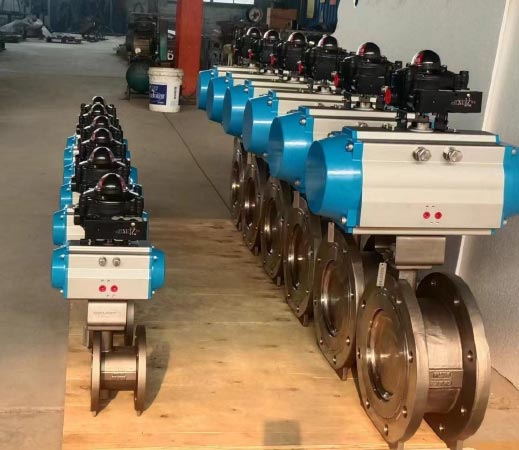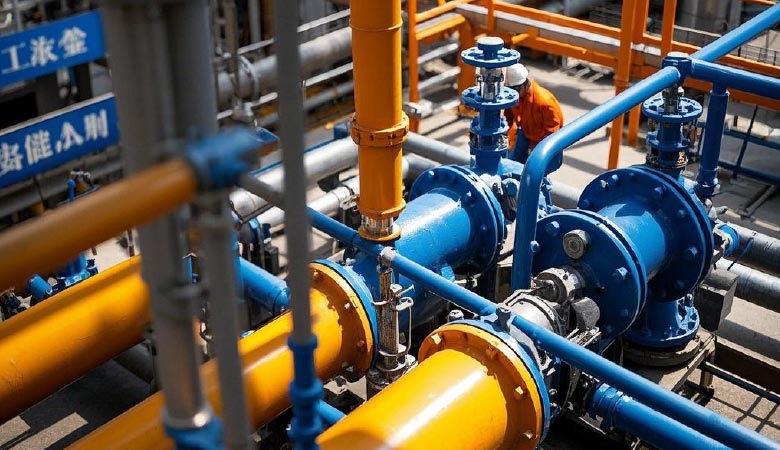High-performance butterfly valves are indispensable in the chemical industry due to their corrosion resistance, ability to withstand high temperatures and pressures, and excellent sealing properties. These valves are widely used in various chemical processes and plant types, including:

- Petrochemical Plants: Crude oil pipelines, refining units, cracking units, and finished product pipelines. They regulate flow and pressure, handling high temperatures, high pressures, and corrosive media.
- Fertilizer Plants: Ammonia synthesis units, urea units, ammonium phosphate units, and gas transmission pipelines. They control the flow of raw material gases (such as nitrogen and hydrogen) and chemicals, ensuring stable reactions.
- Chlor-Alkali Plants: Electrolytic cell inlets and outlets, chlorine pipelines, and caustic soda pipelines. Their corrosion resistance is vital for handling highly corrosive media like chlorine and caustic soda.
- Sulfuric Acid Plants: Sulfur combustion units, sulfur dioxide pipelines, and sulfuric acid pipelines. They withstand high temperatures and corrosion, essential for the strong acid environment of sulfuric acid production.
- Nitric Acid Plants: Ammonia oxidation units, nitric acid pipelines, and exhaust gas treatment systems. They control the flow of ammonia and nitric acid, operating in high-temperature and corrosive environments.
- Methanol Plants: Synthesis gas pipelines, methanol synthesis units, and methanol pipelines. They regulate the flow of synthesis gas and methanol, ensuring reaction efficiency.
- Ethylene Plants: Cracker inlets and outlets, ethylene pipelines, and compression systems. They operate in high-temperature and high-pressure environments, controlling the flow of ethylene and its byproducts.
- Polyolefin Plants: Polymerization reactor inlets and outlets, monomer pipelines, and finished product pipelines. They control the flow of monomers and polymers, ensuring product quality.
- Styrene Plants: Ethylbenzene dehydrogenation units, styrene pipelines, and exhaust gas treatment systems. They regulate the flow of ethylbenzene and styrene, handling high temperatures and corrosive media.
- Pesticide Plants: Raw material pipelines, reactor inlets and outlets, and wastewater treatment systems. Their corrosion resistance is crucial for handling toxic and corrosive media in pesticide production.
- Dye Plants: Dye synthesis units, raw material pipelines, and wastewater treatment systems. They control the flow of dyes and chemicals, operating in high-temperature and corrosive environments.
- Paint Plants: Resin synthesis units, solvent pipelines, and finished product pipelines. They regulate the flow of resins and solvents, ensuring paint quality.
- Rubber Plants: Rubber synthesis units, monomer pipelines, and exhaust gas treatment systems. They control the flow of monomers and rubber, handling high temperatures and corrosive media.
- Chemical Fiber Plants: Polymerization units, spinning solution pipelines, and wastewater treatment systems. They regulate polymer flow, ensuring the quality of chemical fiber products.
- Gas Chemical Plants: Gas separation units, gas pipelines, and compression systems. They control the flow of industrial gases such as oxygen, nitrogen, and hydrogen.
- Wastewater Treatment Plants (Chemical Parks): Wastewater collection pipelines, treatment equipment inlets and outlets, and discharge pipelines. They regulate wastewater flow, ensuring treatment effectiveness.
- Solvent Plants: Solvent synthesis units, raw material pipelines, and finished product pipelines. They control the flow of solvents and chemicals, handling corrosive media.
- Catalyst Plants: Catalyst synthesis units, raw material pipelines, and exhaust gas treatment systems. They regulate the flow of raw materials and catalysts, ensuring product quality.

- Summary
High-performance butterfly valves are widely used in various chemical plants, including petrochemical, fertilizer, chlor-alkali, sulfuric acid, nitric acid, methanol, ethylene, polyolefin, styrene, pesticide, dye, paint, rubber, chemical fiber, gas chemical, wastewater treatment, solvent, and catalyst plants. Their primary functions are flow regulation, pressure control, and leakage prevention, while adapting to complex working conditions such as high temperature, high pressure, and corrosive media.
Contact Shengfei today for high-quality butterfly valve solutions tailored to your chemical plants processing needs.
Web: www.shengfeimachinery.com
Mail: sales@shengfeimachinery.com
